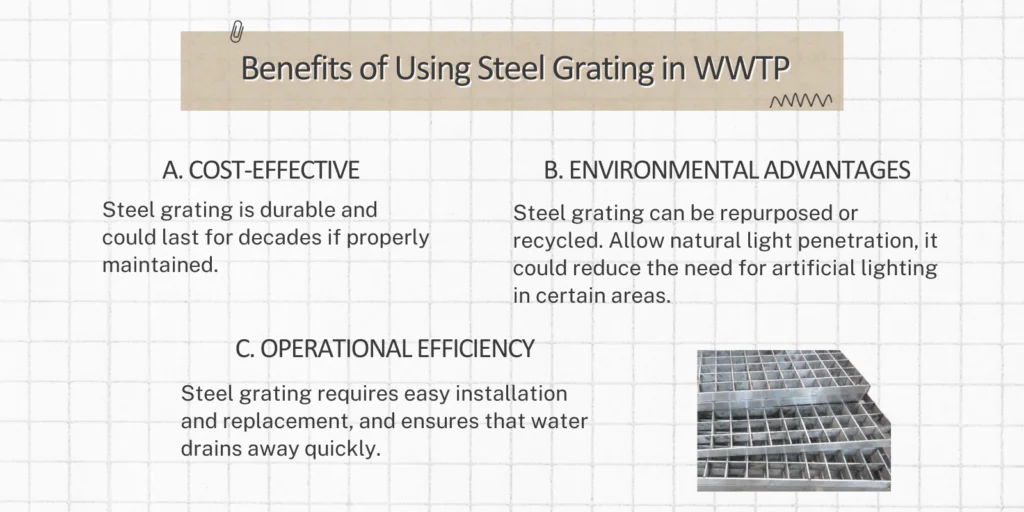Have you ever wondered how wastewater treatment plants manage to operate efficiently and safely, even in the most challenging conditions? The Problem is clear: these plants deal with vast amounts of water, potential slippages, and the need for durable infrastructure. Agitation grows when considering the environmental and safety hazards that can arise if these challenges aren’t addressed. But there’s a Solution: steel grating.
Steel grating plays a pivotal role in ensuring that wastewater treatment plants run smoothly. Its unique design and properties offer optimal support, safety, and operational efficiency. By providing a non-slip surface, allowing for effective ventilation, and being incredibly durable, steel grating becomes an unsung hero in these facilities.
As you delve deeper into this article, you’ll discover the multifaceted benefits of steel grating and how it significantly aids wastewater treatment plants in their daily operations. So, let’s embark on this enlightening journey and uncover the importance of steel grating in these crucial environmental hubs.
Background on Steel Grating

Definition and Characteristics of Steel Grating
Steel grating is a framework of intersecting steel bars and crossbars, typically made from carbon steel, stainless steel, or other alloys. This grid-like structure is designed to span over open spaces, providing a sturdy walking surface. One of its primary characteristics is its open design, which allows for drainage, ventilation, and the passage of light. Additionally, steel grating is known for its high strength-to-weight ratio, making it a preferred choice for many industrial applications.
Types of Steel Grating and Their Specific Features
There are several types of steel grating, each tailored for specific applications
| Pressed locked Grating | Made by pressing flat steel bars at uniform intervals. It’s known for its lightweight and aesthetic appeal. |
| Welded Steel Grating | Produced by welding the crossbars to the bearing bars. This type is robust and is commonly used in heavy-load applications. |
| Riveted Grating | Rivets connect the crossbars to the bearing bars, offering excellent load-bearing capabilities and resistance to impact. |
The Role of Steel Grating in WWTP
A. Safety
Safety is paramount in wastewater treatment plants, given the wet and potentially hazardous environments.
- Non-slip Surfaces: Steel grating’s textured and open design inherently offers a non-slip surface. This is crucial in wastewater treatment plants where surfaces are frequently wet, reducing the risk of slips and falls.
- Durability: Steel, especially when treated or coated, can withstand the test of time. Its resistance to wear and tear ensures that walkways and platforms remain safe for workers, requiring minimal maintenance over the years.
B. Support and Durability
In WWTPs, the infrastructure must support both heavy machinery and the daily foot traffic of workers.
- Ability to Bear Heavy Loads: Steel grating’s strength allows it to bear substantial weights, making it ideal for areas with heavy machinery or high foot traffic. Its design distributes weight evenly, preventing undue stress on any single point.
- Resistance to Corrosion: Wastewater can be corrosive. However, steel grating, especially when galvanized or coated, offers excellent resistance to rust and corrosion, ensuring longevity and consistent performance.
C. Ventilation and Light Passage
The design of steel grating plays a dual role in promoting both ventilation and the passage of light.
- Optimal Airflow: The open grid design of steel grating ensures that air circulates freely. In WWTPs, this is vital to prevent the accumulation of toxic gases and to maintain a healthy environment for workers.
- Natural Light Penetration: The spaces between the bars in steel grating allow natural light to filter through. This not only reduces the need for artificial lighting but also creates a more pleasant working environment.
Benefits of Using Steel Grating in WWTP

A. Cost-Effective
One of the primary advantages of using steel grating in wastewater treatment plants is its cost-effectiveness.
Long Lifespan: Steel grating is renowned for its durability. When properly maintained, it can last for decades, reducing the need for frequent replacements and thereby saving costs in the long run.
Minimal Maintenance Requirements: Unlike other materials that may degrade quickly in the challenging environment of a WWTP, steel grating requires minimal upkeep. Its resistance to corrosion and wear ensures that maintenance costs remain low.
B. Environmental Advantages
Steel grating also offers several environmental benefits.
Recyclability of Steel Grating: Steel is highly recyclable. At the end of its lifecycle, steel grating can be repurposed or recycled, reducing waste and promoting sustainability.
Reduction in Energy Consumption: The ability of steel grating to allow natural light penetration can significantly reduce the need for artificial lighting in certain areas of the WWTP. This not only saves on energy costs but also reduces the carbon footprint of the facility.
C. Operational Efficiency
Operational efficiency is crucial in WWTPs, and steel grating contributes significantly to this.
Easy to Install and Replace: Steel grating modules are designed for ease of installation. Should a section become damaged or need replacement, it can be done with minimal disruption to the plant’s operations.
Quick Drainage: The open design of steel grating ensures that water drains away quickly, preventing waterlogging and potential damage to equipment or infrastructure.
Case Study: A Real-World Application

In the bustling city of Melbourne, the Western Treatment Plant stands as a testament to modern wastewater management. Covering over 110 square kilometers, it’s one of the largest facilities of its kind in the Southern Hemisphere.
One of the notable features of this plant is its extensive use of steel grating. From walkways to machinery platforms, steel grating is a common sight. The facility management has often praised its decision to incorporate steel grating, citing its durability and safety features as top benefits. In a recent review, the management mentioned that the installation of steel grating has led to fewer maintenance shutdowns and has improved overall worker safety.
Furthermore, the plant has seen a reduction in energy costs, especially in areas where natural light can now be utilized instead of artificial lighting. The recyclability of steel grating also aligns with the plant’s sustainability goals, making it a win-win solution.
This real-world application underscores the myriad benefits of steel grating in wastewater treatment plants, highlighting its role in ensuring safety, sustainability, and operational efficiency.
Considerations When Choosing Steel Grating for WWTP
When selecting steel grating for wastewater treatment plants, it’s essential to consider several factors to ensure the grating meets the specific needs of the facility.
| Load-Bearing Needs | Assess load requirements in different WWTP areas. Heavy machinery areas need stronger grating than pedestrian zones. |
| Corrosion Resistance | Essential due to wastewater and chemicals. Choose galvanized or coated steel for better rust resistance. |
| Grating Type | Select the right type for specific needs, like better foot traction or preventing object falls. |
| Quality and Standards | Ensure grating meets industry standards for safety, longevity, and operational efficiency. |
Conclusion
Throughout this exploration, the pivotal role of steel grating in wastewater treatment plants has been evident. Its unique design and properties, from ensuring safety with its non-slip surfaces to promoting operational efficiency with its durability and ease of maintenance, make it an indispensable component in these facilities.
As our world continues to urbanize and the need for effective wastewater management grows, the importance of reliable infrastructure becomes even more pronounced. Steel grating stands out as a solution that addresses multiple challenges faced by WWTPs.
To industries and facility managers, the message is clear: investing in quality steel grating is not just a matter of operational efficiency; it’s a commitment to safety, sustainability, and long-term cost savings. Embracing steel grating is a step forward in building a resilient and environmentally-friendly future.


